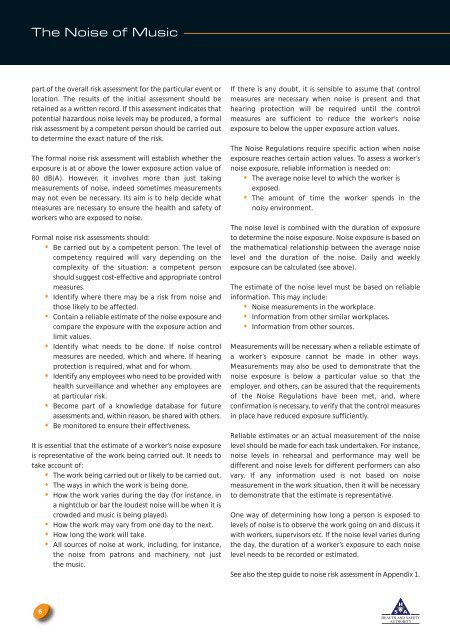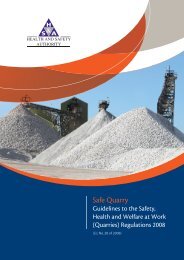The Noise of Music.pdf - Health and Safety Authority
The Noise of Music.pdf - Health and Safety Authority
The Noise of Music.pdf - Health and Safety Authority
Create successful ePaper yourself
Turn your PDF publications into a flip-book with our unique Google optimized e-Paper software.
<strong>The</strong> <strong>Noise</strong> <strong>of</strong> <strong>Music</strong><br />
part <strong>of</strong> the overall risk assessment for the particular event or<br />
location. <strong>The</strong> results <strong>of</strong> the initial assessment should be<br />
retained as a written record. If this assessment indicates that<br />
potential hazardous noise levels may be produced, a formal<br />
risk assessment by a competent person should be carried out<br />
to determine the exact nature <strong>of</strong> the risk.<br />
<strong>The</strong> formal noise risk assessment will establish whether the<br />
exposure is at or above the lower exposure action value <strong>of</strong><br />
80 dB(A). However, it involves more than just taking<br />
measurements <strong>of</strong> noise, indeed sometimes measurements<br />
may not even be necessary. Its aim is to help decide what<br />
measures are necessary to ensure the health <strong>and</strong> safety <strong>of</strong><br />
workers who are exposed to noise.<br />
Formal noise risk assessments should:<br />
• Be carried out by a competent person. <strong>The</strong> level <strong>of</strong><br />
competency required will vary depending on the<br />
complexity <strong>of</strong> the situation; a competent person<br />
should suggest cost-effective <strong>and</strong> appropriate control<br />
measures.<br />
• Identify where there may be a risk from noise <strong>and</strong><br />
those likely to be affected.<br />
• Contain a reliable estimate <strong>of</strong> the noise exposure <strong>and</strong><br />
compare the exposure with the exposure action <strong>and</strong><br />
limit values.<br />
• Identify what needs to be done. If noise control<br />
measures are needed, which <strong>and</strong> where. If hearing<br />
protection is required, what <strong>and</strong> for whom.<br />
• Identify any employees who need to be provided with<br />
health surveillance <strong>and</strong> whether any employees are<br />
at particular risk.<br />
• Become part <strong>of</strong> a knowledge database for future<br />
assessments <strong>and</strong>, within reason, be shared with others.<br />
• Be monitored to ensure their effectiveness.<br />
It is essential that the estimate <strong>of</strong> a worker’s noise exposure<br />
is representative <strong>of</strong> the work being carried out. It needs to<br />
take account <strong>of</strong>:<br />
• <strong>The</strong> work being carried out or likely to be carried out.<br />
• <strong>The</strong> ways in which the work is being done.<br />
• How the work varies during the day (for instance, in<br />
a nightclub or bar the loudest noise will be when it is<br />
crowded <strong>and</strong> music is being played).<br />
• How the work may vary from one day to the next.<br />
• How long the work will take.<br />
• All sources <strong>of</strong> noise at work, including, for instance,<br />
the noise from patrons <strong>and</strong> machinery, not just<br />
the music.<br />
If there is any doubt, it is sensible to assume that control<br />
measures are necessary when noise is present <strong>and</strong> that<br />
hearing protection will be required until the control<br />
measures are sufficient to reduce the worker’s noise<br />
exposure to below the upper exposure action values.<br />
<strong>The</strong> <strong>Noise</strong> Regulations require specific action when noise<br />
exposure reaches certain action values. To assess a worker’s<br />
noise exposure, reliable information is needed on:<br />
• <strong>The</strong> average noise level to which the worker is<br />
exposed.<br />
• <strong>The</strong> amount <strong>of</strong> time the worker spends in the<br />
noisy environment.<br />
<strong>The</strong> noise level is combined with the duration <strong>of</strong> exposure<br />
to determine the noise exposure. <strong>Noise</strong> exposure is based on<br />
the mathematical relationship between the average noise<br />
level <strong>and</strong> the duration <strong>of</strong> the noise. Daily <strong>and</strong> weekly<br />
exposure can be calculated (see above).<br />
<strong>The</strong> estimate <strong>of</strong> the noise level must be based on reliable<br />
information. This may include:<br />
• <strong>Noise</strong> measurements in the workplace.<br />
• Information from other similar workplaces.<br />
• Information from other sources.<br />
Measurements will be necessary when a reliable estimate <strong>of</strong><br />
a worker’s exposure cannot be made in other ways.<br />
Measurements may also be used to demonstrate that the<br />
noise exposure is below a particular value so that the<br />
employer, <strong>and</strong> others, can be assured that the requirements<br />
<strong>of</strong> the <strong>Noise</strong> Regulations have been met, <strong>and</strong>, where<br />
confirmation is necessary, to verify that the control measures<br />
in place have reduced exposure sufficiently.<br />
Reliable estimates or an actual measurement <strong>of</strong> the noise<br />
level should be made for each task undertaken. For instance,<br />
noise levels in rehearsal <strong>and</strong> performance may well be<br />
different <strong>and</strong> noise levels for different performers can also<br />
vary. If any information used is not based on noise<br />
measurement in the work situation, then it will be necessary<br />
to demonstrate that the estimate is representative.<br />
One way <strong>of</strong> determining how long a person is exposed to<br />
levels <strong>of</strong> noise is to observe the work going on <strong>and</strong> discuss it<br />
with workers, supervisors etc. If the noise level varies during<br />
the day, the duration <strong>of</strong> a worker’s exposure to each noise<br />
level needs to be recorded or estimated.<br />
See also the step guide to noise risk assessment in Appendix 1.<br />
6

















